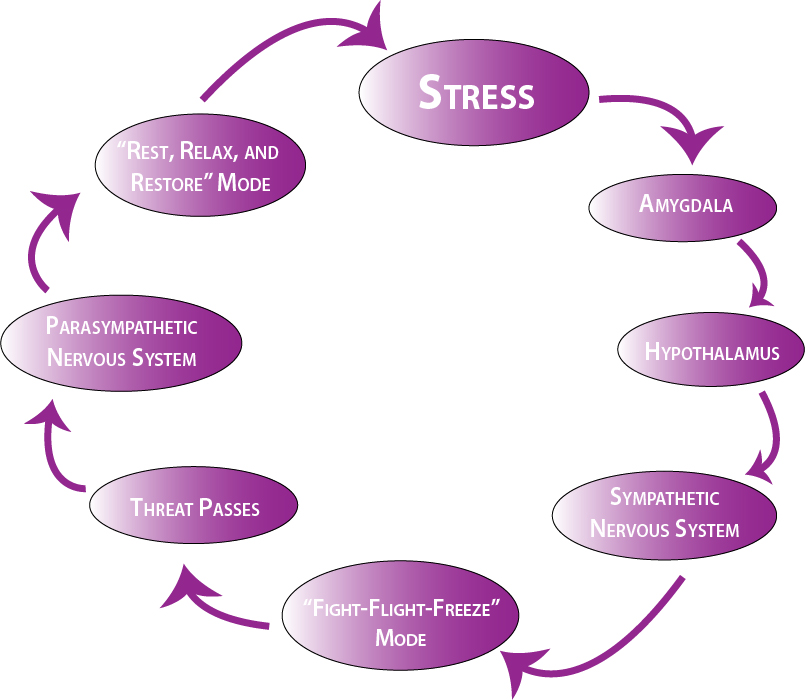FIGHT-or-FLIGHT
=
FAT STORING MODE

By Karen Donaldson
The Stress Response
We know that stress plays a HUGE role in our ability to lose weight and keep it off, and a basic understanding of what happens in your brain is vital to your successful weight loss. The stress response begins in a part of the brain called the amygdala. It’s a funny sounding word, but the amygdala plays a major role in processing our emotions. When it perceives danger, it sends out a warning signal to the hypothalamus, which acts like the “command center”. The hypothalamus communicates with the rest of the body through the sympathetic nervous system.
When you’re stressed, all systems are on high alert to make sure you have enough energy and resources to prepare you for “fight-or-flight” mode. Your adrenal glands get a message to amp up the production of cortisol and adrenaline. The increased adrenaline levels speed up your heart rate, rushing blood to your muscles and other vital organs. Your blood pressure and breathing rate also increase and extra oxygen gets sent to your brain to increase alertness.
Meanwhile, the adrenaline and cortisol tell your liver and other storage sites in your body to release fats and sugars into your blood to be used as fuel to handle the “emergency”. Cortisol also shuts down any non-essential functions like digestion, reproduction, and your immune system. If you don’t actually need to “run from the bear”, this stress response contributes to weight issues by creating the perfect storm to store fat – right in your belly!
When the threat has passed, your parasympathetic nervous system takes over and helps return your body to “rest, relax, and restore” mode. Your stress hormones (the adrenaline and cortisol) levels should decrease, and your mind and body should recover, returning to a more calm and balanced state.
However, if you’re in a chronic state of anxiety or constantly in fight-flight-or-freeze mode your body struggles to return to “rest, relax and restore” mode. Your stress hormones are continously “amped up” and you stay stuck in fat-storing mode instead of fat-releasing mode.
Here’s how it SHOULD work:
STRESS > amygdala > hypothalamus > sympathetic nervous system > “fight-or-flight” mode > threat passes > parasympathetic nervous system > “rest, relax, and restore” mode

For way too many people (myself included at times), modern-day stressors are CONSTANT and the body feels under attack 24/7. This keeps us in what I call chronic fight-or-flight mode. Until your find a new way of reacting to the stress, the cycle never ends.
How many times per day do you feel that anxious, revved-up feeling?
The effects on our health and weight are disastrous. Constant surges of adrenaline can damage our blood vessels and arteries, which can raise blood pressure and increase our risk of heart attack or stroke. It also puts you at risk for health issues such as depression, anxiety, digestive disorders, concentration problems, memory issues, fatigue, and insomnia. Sustained high cortisol levels gradually tear down your body by destroying healthy muscle and bone, slowing down healing, and weakening your immune system.
As far as weight goes, cortisol promotes the breakdown of fats and sugars for energy during “emergencies”. Chronically high levels of this hormone indirectly contribute to the storage of fat tissue and weight gain. Your brain doesn’t know you’re not actually running from the bear in the woods, and your body has to do something with all those sugars and fats that were released into your blood. Your insulin levels also rise in response to the increases in blood sugars and you’ve just set the stage to store more belly fat. Aaargh! Talk about stress!
To make matters worse, if you can’t literally run from the bear (i.e. “life”), you find other ways to cope. You may want to punch your boss in the face (fight) or run away from the bills (flee), but those, sorry to say, aren’t really viable options.
For many folks, the easiest thing to relieve stress is to eat. Carbs. Lots of them. Foods and beverages high in carbohydrates can have a calming effect on the brain by raising serotonin levels. The sugars can also trigger the reward center of the brain, causing spikes in dopamine, which may induce even stronger cravings for those comfort foods.
Your memories and emotions only intensify the cravings . . . “Grandma always baked me cookies when I was having a bad day and the cookies always made me feel better and besides I deserve a treat because it’s been a long week. I’ll just have a couple and I promise I’ll be good tomorrow and . . . so on and so on.” It’s a vicious cycle but one you can break when you know how to calm your stress response.
BE SURE TO WATCH THE VIDEO ON HOW TO CALM YOUR STRESS RESPONSE USING THE “PRESS AND BREATHE TECHNIQUE”

